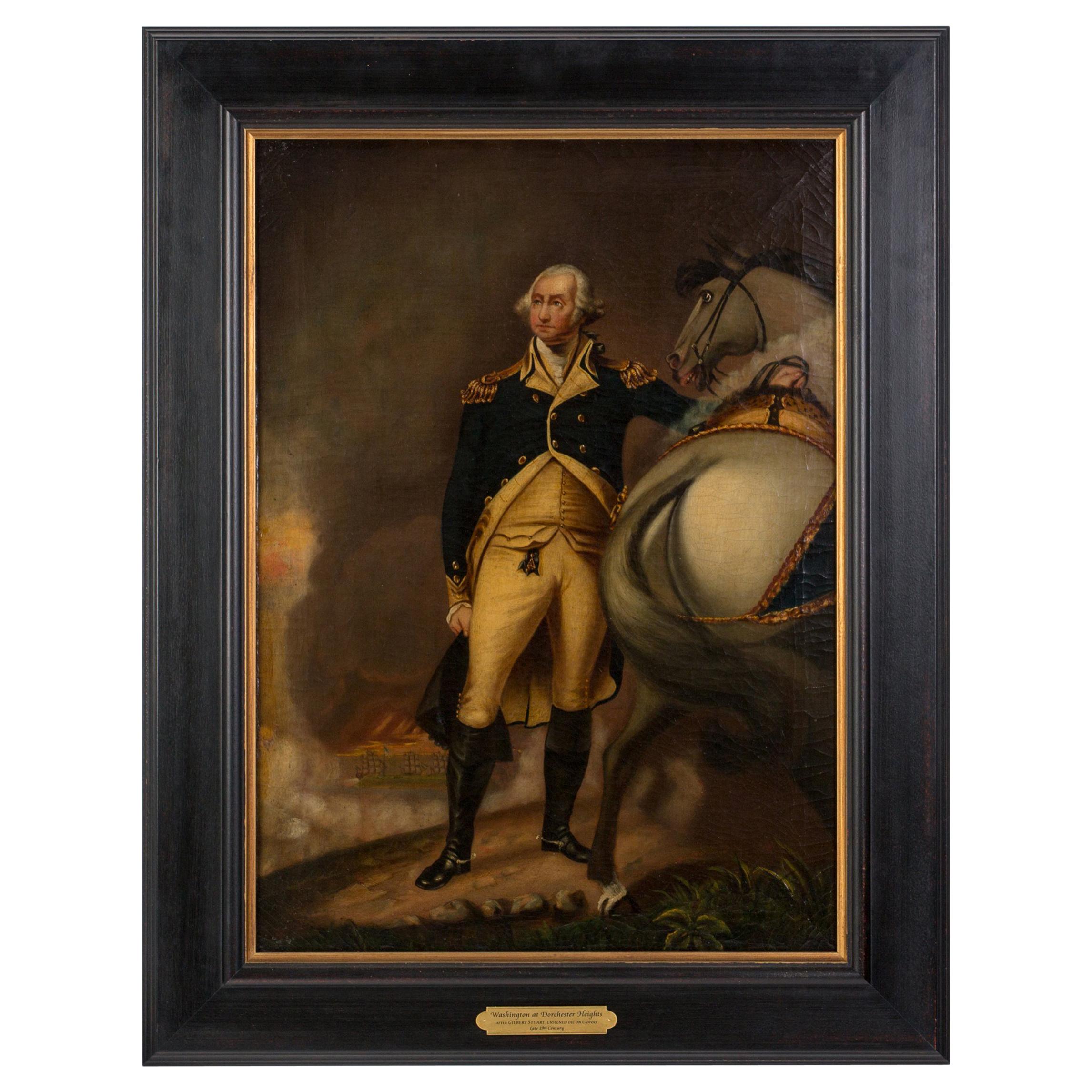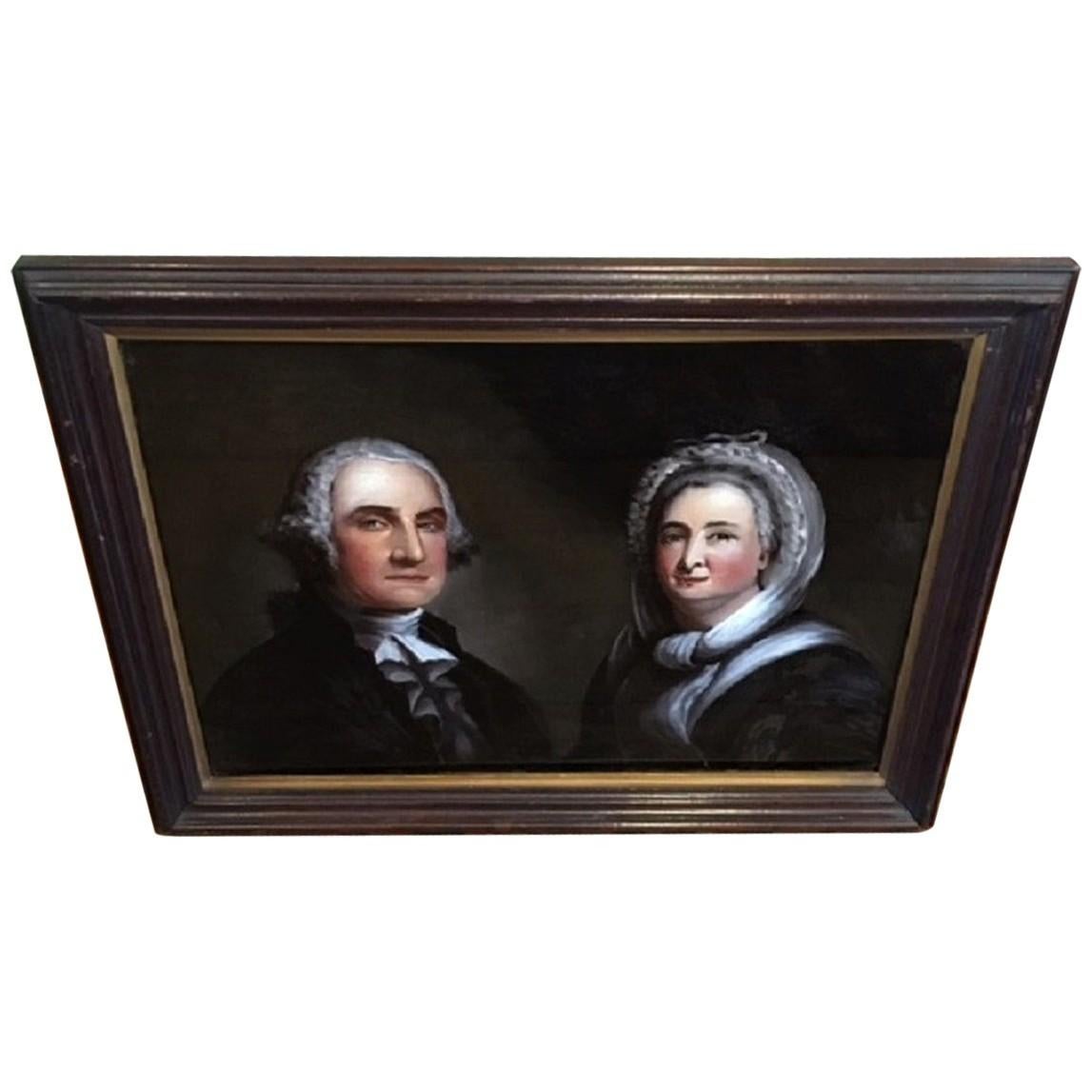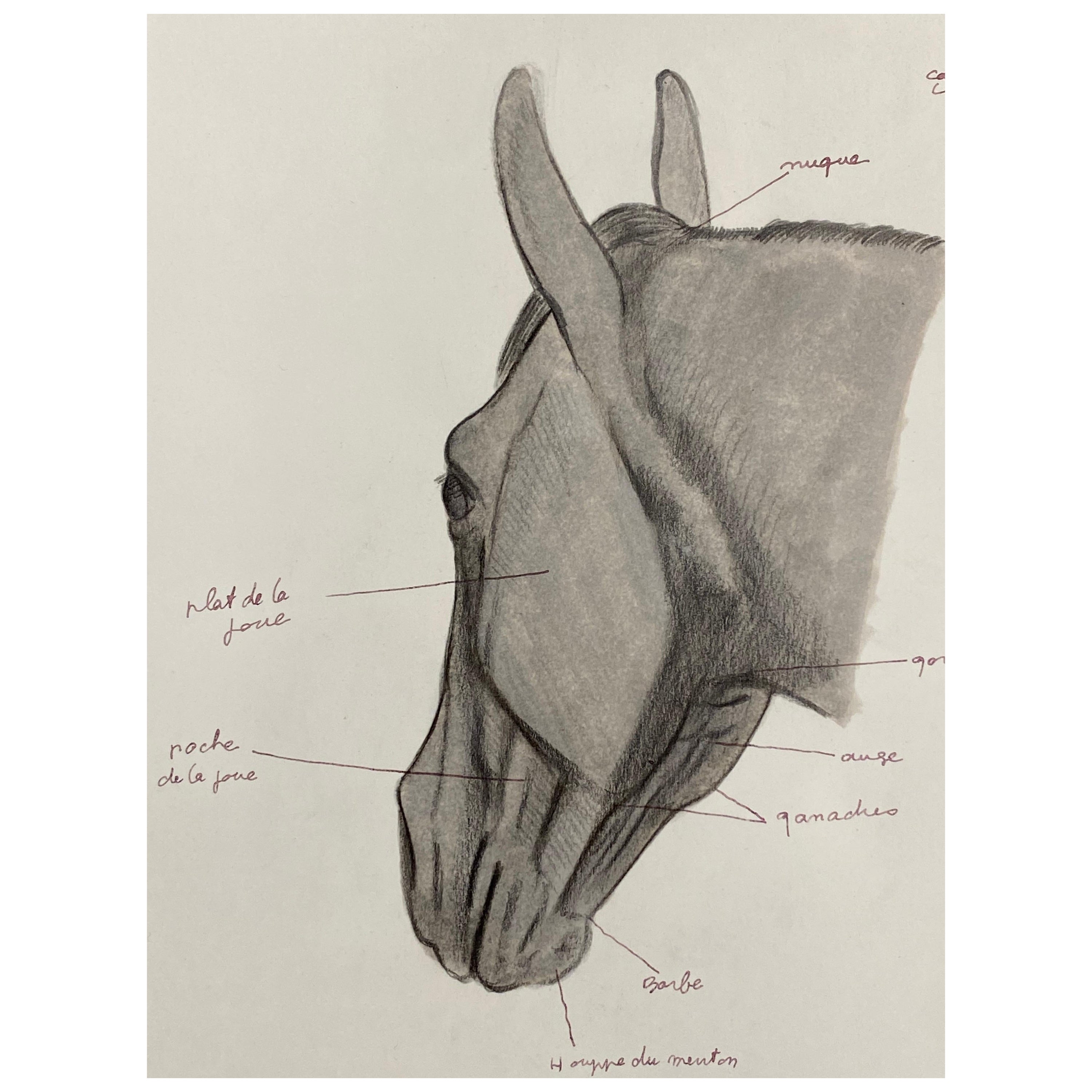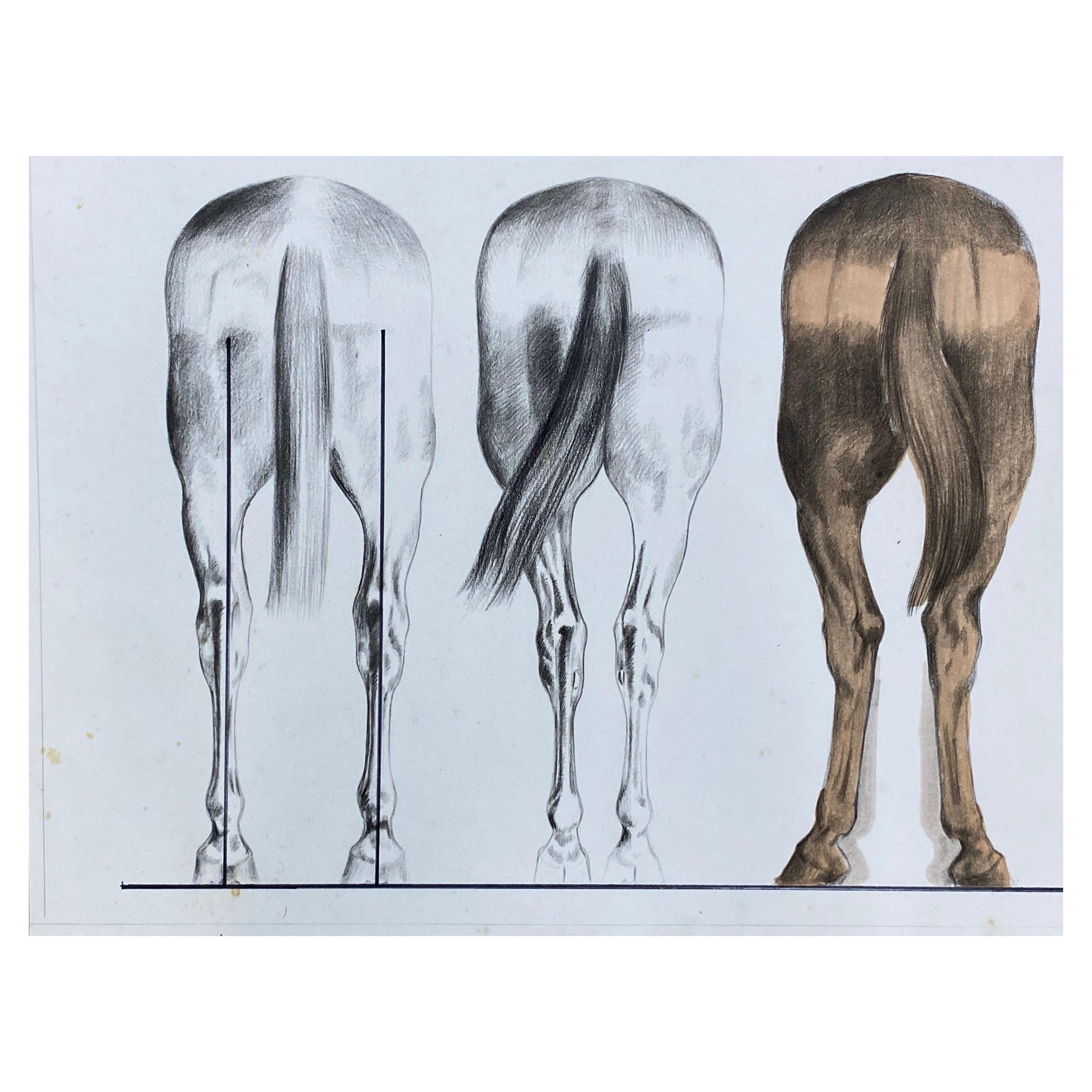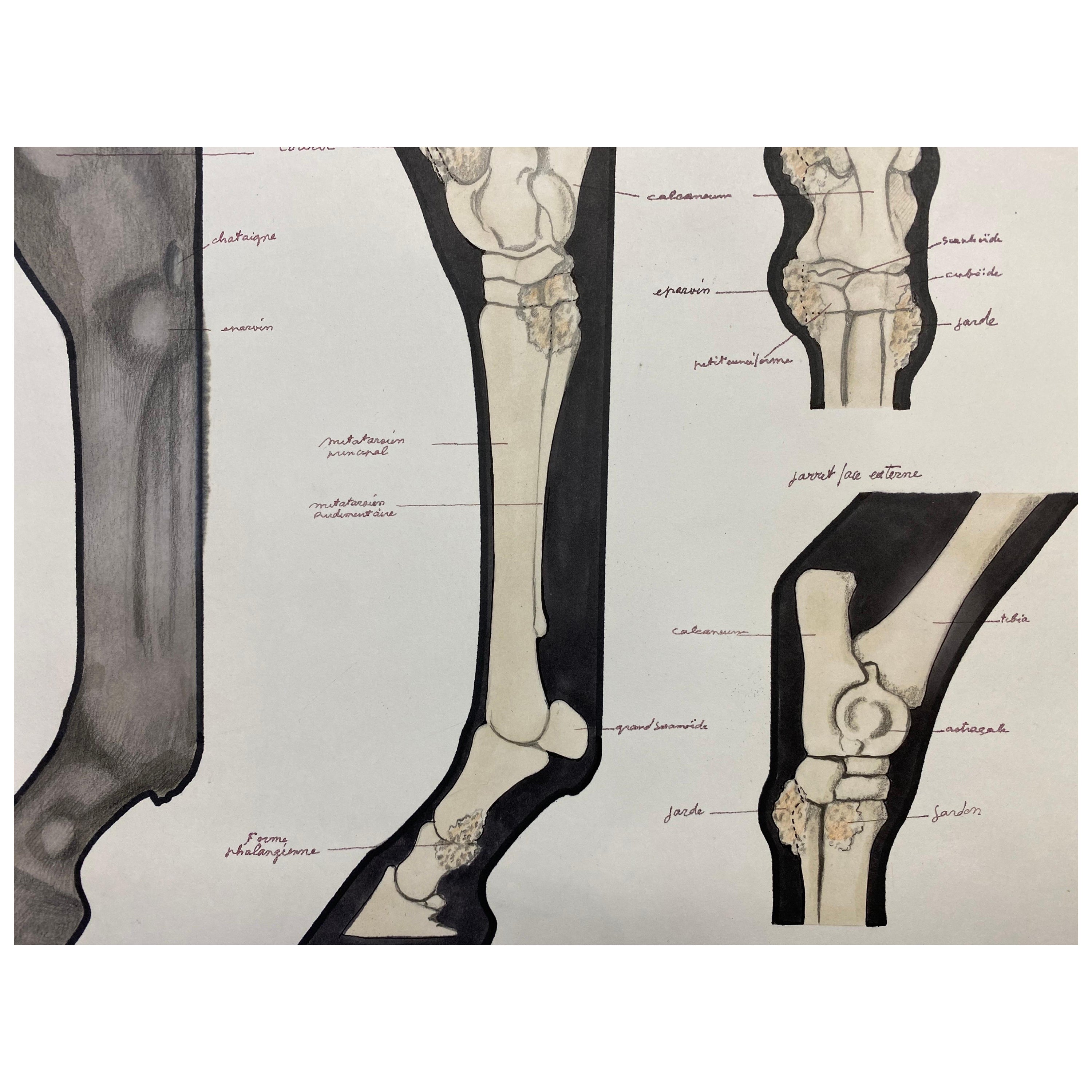Items Similar to "Equestrian Washington" O/C of Washington on Blueskin, After Rembrandt Peale
Want more images or videos?
Request additional images or videos from the seller
1 of 8
"Equestrian Washington" O/C of Washington on Blueskin, After Rembrandt Peale
About the Item
“EQUESTRIAN WASHINGTON,” OIL ON CANVAS PAINTING OF GEORGE WASHINGTON ON BLUESKIN, AFTER REMBRANDT PEALE, circa 1830-1850 (POSSIBLY PRIOR):
Born in Bucks County Pennsylvania during the American Revolution, Rembrandt Peale (Feb. 22, 1778 – Oct. 3, 1860) was the son of Charles Willson Peale (1741-1827), the leading painter in the American colonies. A member of the Sons of Liberty, Charles left home shortly after Rembrandt's birth to fight with Washington's army. He taught most of his 17 children to paint, of which Rembrandt is the most celebrated, though two others, as well as an adopted nephew, achieved significant notoriety.
Charles was one of the two most famous artists to paint Washington from life, the other being Gilbert Stuart (1755-1828). The last to do so was Rembrandt Peale, at the mere age of 17, whom Washington sat for in 1795, near the end of his presidency. This became the most celebrated feather in the cap of the young artist, who proudly wore it for the remainder of his life when marketing his trade. The sketch that he created that day laid the groundwork for not only his repute for having done so, but also a crazed obsession to create what he desperately hoped would someday become the “national portrait and the “standard likeness” of Washington.
The most familiar of Rembrandt’s paintings of the president & general is regarded as the “porthole portrait,” a three-quarter, head and shoulders image, painted in 1824, that illustrated him in a blue and buff yellow military coat, with prominent epaulettes, presenting the subject as if viewed through an oval window, painted as part of the canvas. Also of great significance was an 1823 work that pictured him on horseback, entitled Before the Battle of Yorktown, accompanied by Henry Knox, Alexander Hamilton, Lafayette, and Rochambeau.*
Next to his father and Stuart, Rembrandt Peale’s renditions of Washington are the most recognizable, perhaps in a near tie with those of the artist John Trumbull (1756-1843), who for a short time, in 1776, served as the general’s aide-de-camp. All four men trained in Great Britain under Benjamin West, arguably the most celebrated painter world-wide. West encouraged each to paint historical views of American figures and achievements, offering advice to the young Rembrandt Peale specifically, conveyed to him in a letter by his father, suggesting that he consider subjects that possessed “powers to dignify man.”
This view of Washington, upon his horse, commonly referred to as “Equestrian Washington,” is widely thought to have been first painted by Rembrandt. Although this work has sometimes been equated with various paintings rendered in the 1820’s, that illustrated him on horseback with various staff, on or about the battlefield (i.e., the Yorktown picture), this work instead presents him as a lone figure on a horse before a tree-lined landscape, with a presumed army encamped or engaged in the distance, the sky tinged with the red light of fires or cannon.
Leading historian E.P. Richardson, commonly referred to as the ‘Dean of American Art Historians,’ co-founder of the Archives of American Art at the Smithsonian (1954), director of the Detroit Institute of Arts (1945-62), and of Winterthur (1963-66), and of the Board of the Pennsylvania Academy of Fine Arts (1968-70), was of the opinion that Rembrandt produced this work earlier following his 1808 return from Paris. There he would have viewed similar equestrian compositions by European masters. In a Sept. 17th, 1982 letter from E.P. Richardson to Larry Fleishman, Richardson declares: "That is where I place this Washington and the two other versions," suggesting this as “his first attempt to arrive at a GREAT WASHINGTON."
A different story is told by the former owner of a copy of Equestrian Washington named Alexander Randall, the best friend of Rembrandt Peale’s nephew, Alexander Robinson [son of his sister, Angelica and her husband, also named Alexander]. Randall, described as a “fervent admirer of the Peale’s work,” owned a copy of Equestrian Washington, presented to him by his brother, Daniel, which is among the holdings of the Hammond-Harwood House Museum in Annapolis. When he physically met with Rembrandt for the first time, on April 15th, 1858, Rembrandt confirmed that he had, in fact painted the picture and recognized it, explaining that it was actually a copy of an original by his father, Charles Willson Peale, which he had painted during the Revolutionary War. Rembrandt reported to Randall that the original was “purchased by Mr. Bingham, then a wealthy man living in the house where my brother [Daniel] was then boarding.”
If Charles Willson Peale painted such a work, it was either destroyed, lost, or otherwise remains unrecorded. Due to the level of scholarship in this particular field, none of the above possibilities seem especially likely, though I suppose stranger things have happened. William Bingham, a member of the Second Continental Congress, Speaker of the House, Senator, and founder of Pennsylvania Bank, the first bank in the United States, was the wealthiest man in America in 1780. A serious buyer of art, he was an extremely likely candidate for such a painting, if it existed. In 1796, it was Bingham who commissioned one of the most famous of all Washington images, the Lansdowne portrait by Gilbert Stuart, gifted to British Prime Minister Lord Lansdowne, who had secured a peaceful end to the Revolution and had just signed John Jay’s Treaty of 1794, in attempt to cease escalating British harassment of American trade vessels.
Rembrandt Peale was no doubt privy to all sorts of behind the scenes information about the art world at the time, especially with regard to Washington. When the president sat for him in 1795, it occurred in three sessions. On day one, intimidated and nervous, he was joined by his father. Day two was a joint session, with Gilbert Stuart also in attendance, working on what would become known as his Vaughan portrait. Martha Washington was present and teased the young Peale a bit, in good fun.
Another rendition of Equestrian Washington by Rembrandt Peale was handed down through the Jones and Sharp families, thereafter acquired and sold privately by the Adams Davidson Gallery in Washington, DC, then by Kennedy Galleries in NYC in 1982, sold privately in 1987, and offered at Christie’s in 2004, where it sold to a private collector for $1,071,500.
The copy of Equestrian Washington that is the subject of this narrative, rendered in oil on canvas, was likely painted in either the first or second quarter of the 19th century. Conservatively I would place it between approximately 1830 and the 1850’s, though possibly prior. Though different in several regards from the two copies signed by Peale, the work is of extraordinarily fine quality. The most readily noticeable differences lay in Washington’s face, in the head of Blueskin and in the presentation of his mane, and in the level of detail within the surrounding landscape. Note how the eyes of Blueskin, in this copy, are especially prominent, gleaming, and conspicuously mouse-like. The heads in both of the above paintings, each signed by Rembrandt, are narrower, and the flowing manes more like those of humans than horses. More attention is given to the surroundings by Peale, but perhaps the most critical feature, with regard to the convincing nature of any Washington image, is his face. Though Rembrandt sought throughout his lifetime to achieve the most accurate, recognizable, and enduring presentation of Washington, that would solidify itself in the American consciousness, this copy of Peale’s work, unsigned and unattributed, conveys what I would suggest is a better rendering of both man and horse, at least with regard to my expectations. The face is predictably his. The mane of the commander-in-chief’s warhorse would be cropped or at the very least orderly, so that the general would be unencumbered.
One has to wonder if this copy may have been a product of another Peale, perhaps one of Rembrandt’s siblings, or instead commissioned by an art dealer such as Parisian-American Leon Goupil, a leading print-maker in Paris and London who expanded into paintings, maintained a gallery on Broadway in New York, and was very successful with American historical works. It was Goupil who convinced Emanuel Leutze to paint his 12’5” x 21’3” replica of Washington Crossing the Delaware, shortly after his completion of the first. Goupil then sold the massive work to a collector, following its exhibition at the Stuyvesant Institute, where, in spite of it being a one painting show, 50,000 people attended and paid to view it. Colonial and Revolutionary American personalities were enormously popular at the time. Goupil would have attracted highly skilled painters of all sorts for commissioned copies.
Whatever the case may be, the image in this copy of Equestrian Washington is compelling, and the neoclassical, old master style, fitting for both the subject and period. What I perhaps like most about this rendition, past its fine quality, the recognizable face, and the whimsically memorable eyes of Blueskin, is the simple fact that this view of Washington, while familiar, is not standard fare. It feels like it should be everywhere, but it isn’t. Because of this, it will be both appreciated by viewers and remembered.
Framing: The decorative, gilt frame is approximately period to the work. Though likely not original, it is very fitting.
Condition: At some point small creases, losses, and tears were repaired and the canvas was adhered to wooden panel. Though its provenance remains unknown, for a period of time the work hung at the New York Hilton on 6th Ave., between 53rd & 54th Streets. When I acquired it there were various small losses and abrasions in the background, three extremely small areas of paint loss and a couple of tiny flecks of the same in the horse, and a few tiny flecks in Washington’s uniform. I had these filled and restored, with a light varnish applied to match its already pleasant luster. The frame had many losses and was carefully restored.
* As the 50th anniversary of American Independence approached, Rembrandt sought to convince Congress to commission from him a large and prominent painting of Washington, to be installed in the U.S. Capitol’s recently constructed rotunda. This became integral to Peale’s goal of instilling the most familiar image of the father of our country. Rembrandt painted a 36 x 29-inch version of “Before the Battle of Yorktown” in 1823, as a means to market the much larger canvas that he intended to sell. In spite of ongoing rejection, and as enormous paintings were instead acquired from his competitor, John Trumbull, which Rembrandt disliked, he nonetheless began an 139 x 121-inch version of the Yorktown work in 1824, in undeterred anticipation of success. Though the hoped for purchase was never consummated, the work was twice lent to the capitol and displayed in the rotunda during Rembrandt’s lifetime. According to a letter penned by Rembrandt to an unidentified gentleman on April 12th, 1858, one of these instances was in progress at that time. Rembrandt passed about 2.5 years later, just 34 days before the 1860 presidential election, when Lincoln gained the White House.
Never installed, the enormous 11.5 x 10-foot (approx.) oil-on-canvas of Before the Battle of Yorktown” was gifted in Mt. Vernon in 1873, and, due to its being too large for any available wall, was subsequently loaned to the Corcoran Gallery of Art in DC, in 1944. The latter institution would eventually acquire the picture, the holdings of which were recently transferred to the National Portrait Gallery. The smaller version was sold at Christie’s in 1999 for $1,045,000.
** Penned in a Sept. 17th, 1982 letter from E.P. Richardson to Larry Fleishman.
- Dimensions:Height: 37.25 in (94.62 cm)Width: 32.25 in (81.92 cm)Depth: 3 in (7.62 cm)
- Materials and Techniques:
- Place of Origin:
- Period:
- Date of Manufacture:1830-1850
- Condition:See Item Description.
- Seller Location:York County, PA
- Reference Number:
About the Seller
5.0
Recognized Seller
These prestigious sellers are industry leaders and represent the highest echelon for item quality and design.
Established in 1991
1stDibs seller since 2008
61 sales on 1stDibs
Typical response time: 9 hours
- ShippingRetrieving quote...Ships From: York County, PA
- Return PolicyThis item cannot be returned.
More From This SellerView All
- George Washington Painting, Oil on Canvas, ca 1850Located in York County, PAPainting of George Washington in oil on canvas, an early example, rendered circa 1850, a very pleasing and well-executed copy of Gilbert ...Category
Antique 1850s American Paintings
MaterialsCanvas
- 1888 Calligraphy of Diana, Goddess of the Hunt, Riding a StagLocated in York County, PALarge and elaborate calligraphy drawing featuring Diana, goddess of the hunt, riding a stag, signed and dated 1888: Late 19th century American ...Category
Antique 1880s Paintings
MaterialsPaper
- Rare "I Was there" March on Washington Red Pennant, Dated August 28, 1963Located in York County, PARARE FELT PENNANT FROM THE MARCH ON WASHINGTON, AUGUST 28, 1963, WHEN MARTIN LUTHER KING DELIVERED HIS HISTORIC "I HAVE A DREAM" SPEECH Printed in white pigment on scarlet red felt,...Category
Mid-20th Century American Political and Patriotic Memorabilia
MaterialsFelt
- Printed Linen Kerchief of George Washington, ca 1806, Germantown, PALocated in York County, PAExtraordinarily early (1806) printed linen kerchief glorifying George Washington, Germantown print works, Germantown, Pennsylvania Printed in sepia ink on coarse, white linen, this patriotic kerchief shows a standing portrait of George Washington, above which is a swag valance and the words “The Effect of Principle, Behold the Man”. The portrait is based on a mezzotint after Gilbert Stuart’s very famous painting of Washington in his later years. Stuart painted it in oil on canvas for a wealthy merchant by the name of William Constable, who commissioned the work for Alexander Hamilton. The kerchief is interesting because it is both American-made and documented. This is exceptionally unusual for any printed textile of the 19th century or prior and the earlier the time period the more unlikely an object is to be identified. This kerchief and a companion piece entitled “The Love of Truth Mark the Boy” (also glorifying Washington through the fabled story of the cherry tree), were made ca 1806 by Germantown Print Works in Germantown, Pennsylvania. To the left of Washington's image is a portion of his infamous farewell address to his troops at the end of the Revolutionary War. To the right is a short excerpt from his eulogy. Below these are three images. In the center is a square-rigged tall ship with “Commercial Union” above it, flanked by the American eagle on the left and the British lion...Category
Antique Early 19th Century American Political and Patriotic Memorabilia
MaterialsLinen
- Elaborate Sailor Souvenir of Washington Crossing the Delaware, ca 1885-1912Located in York County, PAElaborate sailor’s souvenir embroidery from the orient with a beautiful hand-painted image of Washington crossing the Delaware, surrounded by a large eagle, federal shield, crossed flags, a cannon, cannonballs, and anchor, circa 1885-1910: Between roughly 1880 and 1915, American sailors visiting the orient could obtain beautiful needlework embroideries on shore, with patriotic American themes. These extraordinary works of art were acquired as mementos of a long voyage, often with the hope that they might be presented as gifts for loved ones and friends. Using silk floss, elaborately embellished with both silver and gold metallic bullion thread...Category
Antique Late 19th Century Asian Political and Patriotic Memorabilia
MaterialsSilk
- Patriotic Silk Kerchief w/ 34 Star Flags & an Image of Washington, Civil War EraLocated in York County, PAPATRIOTIC SILK KERCHIEF OF THE CIVIL WAR PERIOD, WITH AN ENGRAVED IMAGE OF GEORGE WASHINGTON, CROSSED 34 STAR FLAGS, AN EAGLE, AND "UNION FOREVER" SLOGAN: Patriotic kerchiefs that date prior to the 1876 Centennial of American Independence are rare among surviving 19th century textiles. Printed on silk and made during the opening years of the Civil War, this example consists of a white ground with red and blue borders. Inside is a prominent, copper engraved, device that consists of a large image of George Washington, crowned by a spread winged eagle that grasps a billowing streamer in its beak and talons. The ribbon boasts the Federal sentiment "Union Forever." The likeness of Washington is derived from Gilbert Stuart's Athenaeum portrait. Below this is a facsimile of Washington's signature, cradled by crossed American flags, each with 34 stars arranged in circular medallions. Although political textile historian Herbert Ridgway Collins associated this kerchief with the centennial of American independence,* there is overwhelming evidence that it was produced earlier. The large scale is much more indicative of kerchiefs produced in the 1860's and prior. Made of silk, the binding is hand-stitched, which is also common of those produced before 1876. When these facts are added to the pro-Union Civil War slogan and flags in the 34 star count, the combination of all these factors points firmly to Civil War period manufacture. Kansas was admitted into the Union as the 34th state on January 29th, 1861, about two-and-a-half months before the Confederate assault on Fort Sumter that marked the beginning of the Civil War. The 34th star was officially added on July 4th of that year and the star count remained official until July 4th, 1863. Further evidence can be found in an example of this kerchief that resides in the collection of the Adams County, Pennsylvania Historical Society, with firm provenance to a woman by the name of Emma Yount. The story goes like this: “With the Battle of Gettysburg looming and the countryside in turmoil, the Union cavalry rode into Gettysburg on the afternoon of June 30, 1863. The troopers dismounted and lounged in the town while awaiting further orders. During that time, the seven year old daughter of innkeeper Israel Yount, Emma, was playing outside their home when a cavalryman asked her to come and visit with him while he was resting. The cavalryman told her that he missed his young daughter at home and asked if little Emma would hug and kiss him on the cheek to remind him of his daughter, who he felt he might not ever see again. Emma asked her mother if she could do as the cavalryman suggested, and her mother considered the circumstances and allowed Emma to do so. Before leaving, the cavalryman gave young Emma a silk handkerchief he was carrying that featured George Washington's image and patriotic border and flags. Emma kept that handkerchief until her death in 1946 and it was then donated to the Adams County Historical Society.” The trio of brass rings, hand-sewn along the top edge, would have been added by a former owner so that it could be hung vertically. The textile itself is both beautiful in design and rare. Outside of an example pictured by Collins in his book “Threads of History” (Smithsonian Press, 1979), and the copy in the Adams County Historical Society, only three others like it are known to have surfaced, including this example. This condition is excellent for the period and it survives as an exceptional relic of the War Between the States. It is of interest to note that kerchief bears marked similarities to another, especially rare, pro-Union variety, that was produced in London for the American market. Notably larger in scale, but very much alike in terms of the fabric, the printing, the shades of red and blue, the verbiage, and the general overall graphic feel, it was produced by Foster & Porter, a known, English maker of printed kerchiefs. Instead of featuring George Washington, the imagery centers on a large cannon...Category
Antique 1860s American Political and Patriotic Memorabilia
MaterialsSilk
You May Also Like
- "George Washington at Dorchester Heights" after Gilbert Stuart, Oil on CanvasLocated in Colorado Springs, COPresented is a framed oil-on-canvas painting entitled George Washington at Dorchester Heights by an unnamed artist. The painting dates to the mid-to-late 19th century and was modeled after the original 1806 painting by Gilbert Stuart. Gilbert Stuart (1755-1828) is best known for the hundreds of portraits he completed of American politicians and social figures during his lifetime. Stuart hoped to one day paint the first president of the United States, purportedly declaring to a friend: “I expect to make a fortune by Washington.” Stuart took on many government and private commissions during his life; his reputation and skill resulted in George Washington agreeing to sit for Stuart on three separate occasions. George Washington at Dorchester Heights was painted by Stuart in 1806. Washington stands beside his horse with a distant view of the city of Boston...Category
Antique Mid-19th Century American Paintings
MaterialsPaint
- Reverse Painting on Glass of George and Martha Washington by W. M. PriorBy William Matthew PriorLocated in Nantucket, MA19th century reverse painted on glass portrait of George and Martha Washington by William Matthew Prior (1806 - 1873), one of New England'...Category
Antique 1830s American Federal Paintings
MaterialsGlass
- Anatomy of a Horse, Original French Artwork Equestrian Anatomy StudyBy Robert LadouLocated in Cirencester, GBThe Anatomy of a Horse by Robert Ladou (French 1929-2014) original drawing stuck on card in blue folder/ thick paper, unframed size: 14.5 x 9.25 ...Category
20th Century Paintings
MaterialsOther
- Anatomy of a Horse, Original French Artwork Equestrian Anatomy StudyBy Robert LadouLocated in Cirencester, GBThe Anatomy of a Horse by Robert Ladou (French 1929-2014) original drawing stuck on card/ thick paper, unframed size: 11.25 x 15.5 overall size:...Category
20th Century Paintings
MaterialsOther
- Anatomy Drawing of a Horse, Original French Artwork Equestrian Anatomy StudyBy Robert LadouLocated in Cirencester, GBThe Anatomy of a Horse by Robert Ladou (French 1929-2014) original drawing stuck on card in blue folder/ thick paper, unframed drawing: 11.75 x 1...Category
20th Century Paintings
MaterialsOther
- Modern Abstract Expressionism Acrylic on Canvas Painting after Judith GodwinBy Judith GodwinLocated in Buffalo, NYModern abstract expressionism acrylic on canvas painting unsigned but possibly executed by Judith Godwin, period painting, amazing use of color, space an...Category
Mid-20th Century American Expressionist Paintings
MaterialsCanvas, Acrylic
Recently Viewed
View AllMore Ways To Browse
Used Furniture Washington
Renditions Furniture
Childrens Folk Art
Folk Art Of Children
I Antique On Line
Gallery O
Whimsical Art Folk Art
Washington Dc Furniture
Antique Furniture Washington
Used Furniture Washington Dc
U Gallery
George Washington Antique
Large Canvas Art Midcentury
Horse Trading
Pennsylvania House Furniture
Pennsylvania House
Antique Level Collectors
George Washington Figure
